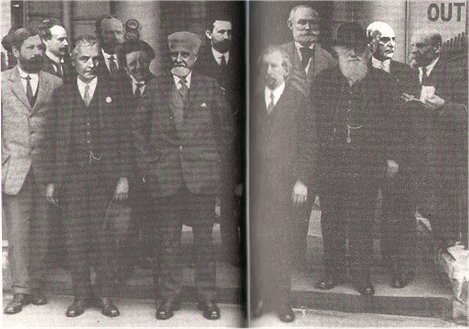

 |
These are the scientists who have all contributed to the science of the genetics during the past century. In the photo they are to be
seen from left to right:
Sigmund Freud, Franz Boaz, John Watson, William James, Jean Piaget, Konrad Lorenz, Emil Kraepelin, Hugo De Vries,
Ivan Pavlov, Charles Darwin, Francis Galton and Emile Durkheim. |
What makes us who we are?
Science writer Matt Ridley chronicles a new revolution in our understanding of genes. he recounts the hundred years' war between the
partisans of nature and nurture to explain how this paradoxical creature, the human being, can be simultaneously free-willed
and motivated by instinct and culture. Nurture depends on genes and genes need nurture. Genes not only predetermine the broad
structure of the brain; they also absorb formative experiences, raect to social cues and even run memory.
An enthralling, up-to-the-minute account of how genes build brains to absorb experience.
The following excerpts from the book are supposed to suggest to you how well Matt Ridley is bringing across his message:
"Bear with me while I take you on a tour of the working of genes. A gene is a stretch of DNA letters encoding the recipe for a protein.
in most cases, however, the gene is broken upo into several stretches of 'sense' interrupted by long stretches of nonsense. The
sense bits are called exons and the nonsense bits introns. After the gene has been transcribed into a working copy
made of RNA and before it has been translated into protein, the introns are removed in a process called splicing.
This was discovered in 1977 by Richard Roberts and Philip Sharp and gained them a Nobel Prize. Walter Gilbert
then realised that there was more to splicing than merely cutting out the nonsense. In some genes, there are several
alternative versions of each exon, lying nose to tail, and only one is chosen; the others are left out. Depending
on which one is chosen, slightly different proteins can be produced from the same gene. Only in recent years, however,
has the full significance of this discovery dawned. It seems to occur in approximately half of all human genes;
it can even involve the splicing in of exons from other genes; and in some cases it produces not just one or two
variants from the same gene, but hundreds or even thousands. .... If a single gene could make thousand of
proteins, then listing human genes would only be the very beginning of the task of listing the number of proteins they
could produce. On the other hand, such complexity made a mockery of the argument that the comparatively few genes
in the human genome was too simple to explain human nature, so people must be the product of experience instead.
..Having argued that a genome of 30,000 genes was too small to determine the deatils of human nature, they would have to admit
that a genome that could produce hundreds of thousands, perhaps even millions, of different proteins had
easily enough combinatorial capacity to specify human nature in excruciating detail, without even bothering
to use nurture."
.......
Now that the genome is available for inspection, and genes can be seen at work, a much less terrifying picture
is emerging. There are morals to be drawn from the nature-nurture debate, and in this chapter, I intend to draw
a few. The first and most general moral is that genes are enablers, not constrainers. They ceate new
possibilities for the organism: they do not cut down its options. Oxytocin receptor genes allow pair-bonding;
without them the prairiw vole (i.e. a kind of mouse) would not have the option of forming a pair bond. CREB genes allow memory;
without those genes, it would be impossible to learn and recall. BDNF allows the calibration of binocular vision through experience;
without it, you could not so easily judge depth and see the world as three-dimensional. FOXP2 mysteriously allows a human being
to acquire the language of his people;; without it, you cannot learn to speak. And so on. ......
They (i.e. genes) are exquisitely good at simple if-thenlogic: if in a certain environment, then develop in a
certain way. If the nearset moving object is a bearded professor, then that is what mothers look like. If reared in famine
conditions, develop a different body type. Girls reared in fatherless households experience earlier puberty - an effect
that is made possible by some still mysterious set of genes. I suspect science has so far greatly underestimated the number of gene
sets that act in this way - conditioning their output to external conditions.
.......
I hope I have shown that the more you discover genes that influence behaviour, the more you find that they work through nurture, and
the more you find that animals learn, the more you discover that learning works through genes.
|


